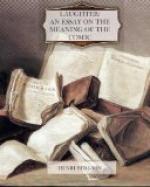Here we apparently find the confirmation of a law, some illustrations of which we have already pointed out. When a comic scene has been reproduced a number of times, it reaches the stage of being a classical type or model. It becomes amusing in itself, quite apart from the causes which render it amusing. Henceforth, new scenes, which are not comic de jure, may become amusing de facto, on account of their partial resemblance to this model. They call up in our mind a more or less confused image which we know to be comical. They range themselves in a category representing an officially recognised type of the comic. The scene of the “robber robbed” belongs to this class. It casts over a host of other scenes a reflection of the comic element it contains. In the end it renders comic any mishap that befalls one through one’s own fault, no matter what the fault or mishap may be,—nay, an allusion to this mishap, a single word that recalls it, is sufficient. There would be nothing amusing in the saying, “It serves you right, George Dandin,” were it not for the comic overtones that take up and re-echo it.
3. We have dwelt at considerable length on repetition and inversion; we now come to the reciprocal interference [Footnote: The word “interference” has here the meaning given to it in Optics, where it indicates the partial superposition and neutralisation, by each other, of two series of light-waves.] of series. This is a comic effect, the precise formula of which is very difficult to disentangle, by reason of the extraordinary variety of forms in which it appears on the stage. Perhaps it might be defined as follows: A situation is invariably comic when it belongs simultaneously to two altogether independent series of events and is capable of being interpreted in two entirely different meanings at the same time.




